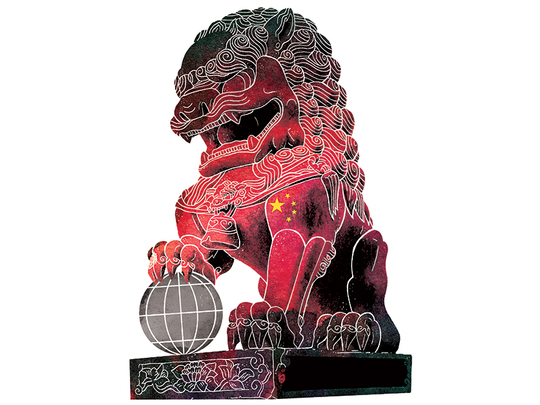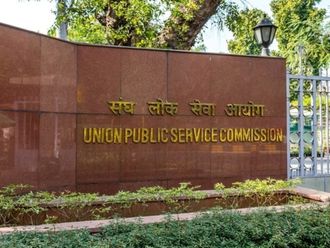
For world powers such as the United States, Japan and their allies, concerns about the rise of China can be traced to one trend: That even as it has integrated itself into the global economy and existing institutions, China has tried to define its role as a major power by creating alternative organisations that challenge the existing regional and global order. A chain of developments in recent months, however — a new Chinese diplomatic activism in the Middle East not least among them — has complicated any judgement of Beijing’s global strategy.
In recent months, the world has witnessed an interesting — at least tactical — adjustment in Chinese diplomacy, away from the “in-your-face” post-2008 assertiveness and towards warmer, friendlier approach to China’s global engagement. One example was the September summit between Chinese President Xi Jinping and US President Barack Obama, where the Chinese leader ostensibly committed to cooperation on the hot-button irritant in Sino-American relations — cybersecurity. Even more dramatic has been Beijing’s back peddling in the region: Xi has twice met Japan’s Prime Minister Shinzo Abe, revived the ROK-China-Japan trilateral mechanism and normalised ties with Vietnam and the Philippines. In his most creative — and unprecedented — move, he met Taiwan’s President Ma Ying-jeou in Singapore.
Hanoi and Manila have been the most combative of competing claimants over the disputed Spratly islands in the South China Sea. China’s charm offensive appears a recognition that its assertive behaviour has been counter-productive and bestowed an unintended gift to the US as the entire region, from Japan to India, has rallied with the US and each other. Perhaps the centrepiece of Xi’s diplomatic offensive has also featured his “pivot” West to Eurasia in response the US “rebalance” in Asia: The “One Road, One Belt” initiative to spread Beijing’s largesse upon its neighbours.
The big question is whether this more benign-appearing Chinese diplomacy is merely a tactical shift, or a recognition that it has seriously overplayed its hand in aggressively pursuing a transparently Sino-centric agenda?
For example, the initial concern when China proposed the Asian Infrastructure Investment Bank (AIIB) was that Beijing might be seeking to displace the Bretton Woods institutions — the World Bank, International Monetary Fund (IMF) and Asian Development Bank (ADB). China says that the AIIB will be a partner of the World Bank and ADB, with compatible standards, not a competitor. But now, as the AIIB launches, the jury is still out.
Yet, the AIIB, Brics bank, the Shanghai Cooperation Organisation, Xi’s call for a new security architecture of “Asia for Asians”, the RMB as a global reserve currency, and even the Boao Forum (an alternative to the Davos World Economic Forum) suggest a competing vision of world order — Beijing’s effort to define its rightful place in the world after a century of humiliation.
Or is it more of a hedging strategy? The train of recent developments may point in another direction: That China is willing to accept a larger role in a reformed international system commensurate with its economic and geopolitical weight. One example is an enhanced Chinese role in the IMF. The Fund recently decided to add the RMB to its basket of currencies known as Special Drawing Rights (SDR), assigning it the second largest share (10.9 per cent) after the US dollar, followed by British pound, yen, and euro. In addition, after the US Congress finally approved the 2010 IMF reform package, China will have its IMF voting shares increased to 7.9 per cent.
China has worked closely with the United States on Climate change and played a pivotal role in the recent COP21 climate change agreement in Paris, pressing developing countries to accept a deal acceptable to the United States and other G-7 nations. Todd Stern, the chief US climate change negotiator afterwards that, “there is no country we cooperate more with than China”.
Perhaps even more interesting is a new Chinese diplomatic activism in the greater Middle East. China has rationalised its free-riding on the US-led international system with one of its core foreign policy principles, like Asean (Association of South-East Asian Nations), of non-interference in the internal affairs of other countries. But as Syrian government officials and Syrian opposition groups gathered in Beijing on December 26, China has decided to help in the search for a resolution of the Syrian civil war where more than 300,000 have been killed and from which several millions of refugees have fled.
After the United Nations Security Council approved a resolution in late December to launch a roadmap for a peace process in Syria, China invited the Syrians to discuss the process. This initiative reflects the wider assertiveness of Chinese foreign policy since the ascension of Xi, who has clearly abandoned the guiding dictum of former Chinese leader Deng Xiao-ping: “Hide your strength, bide your time.”
Similarly, as the US has wound down its military presence in Afghanistan, China has played a more active diplomatic role, seeking to mediate a settlement between the Taliban and the Afghan government. For a decade before, as the US and its allies fought the war in Afghanistan, China was on the sidelines, quietly benefiting as it made multibillion investments in the Afghan mining sector.
China’s growing role in the Middle East is a reflection not only of its desire for international stature, but also of its large and growing economic interests in the region. China imports about 60 per cent of its oil — most of it from the Middle East — and Chinese state-owned oil companies are actively pursuing oil-and-gas investments in the region, particularly in Iraq and Iran.
Whether China’s new activism in the greater Middle East yields positive results is highly problematic. It is likely to be an arduous political process, one that is just beginning in Syria. And a resolution is unlikely until the major outside powers intervening in the conflict — Iran, Russia and Saudi Arabia — find a mutually acceptable outcome. Similarly, fighting in Afghanistan shows little sign of ending, and in fact, has become more complicated, with Daesh (the self-proclaimed Islamic State of Iraq and the Levant) forces entering the conflict. Moreover, China’s leverage in the conflict-engulfed region is limited.
But the key point is that Chinese diplomacy in both cases is consistent with US policies in the region. Given that the Middle East is likely to be engulfed in multi-layered ethnic and religious tension in the coming decade, if this new Chinese diplomacy is a trend, it may be a welcome complement to a beleaguered US diplomacy.
The larger question, however, is whether or not any wider conclusions can be drawn from China’s new activism in the Middle East with regard to Beijing’s global intentions. Does it reflect an acceptance of the current order, provided China wields more substantial power within it, or is China’s diplomatic activism a stepping stone to a revised, Sino-centric order? Whether the AIIB becomes a partner to the World Bank and ADB or a competitor remains to be seen. Will China move towards compromise in the South China Sea dispute? Will Beijing agree to a robust bilateral investment treaty with the US and rollback its nationalist economic policies to allow US firms wider access to the Chinese market? And not least, will it accept international norms in the contested global commons — cyber, air, space and maritime?
For the US and Japan, it will be important to determine what are the key indicators of Chinese intentions? The above-mentioned issues would be a good start for a list of indicators. There are clearly trends in both directions. Some of China’s behaviour seems to fall in the category of “responsible stakeholder” in the global system that the US has encouraged. Some of its activism clearly points in the direction of a revised order. But for the moment, it is difficult to conclude anything but the developments discussed above yield a mixed picture, one that will be clarified over the coming two decades.
(This is a revised and expanded version of an article, an earlier version of which appeared in Nikkei Asian Review.)
— New York Times News Service








